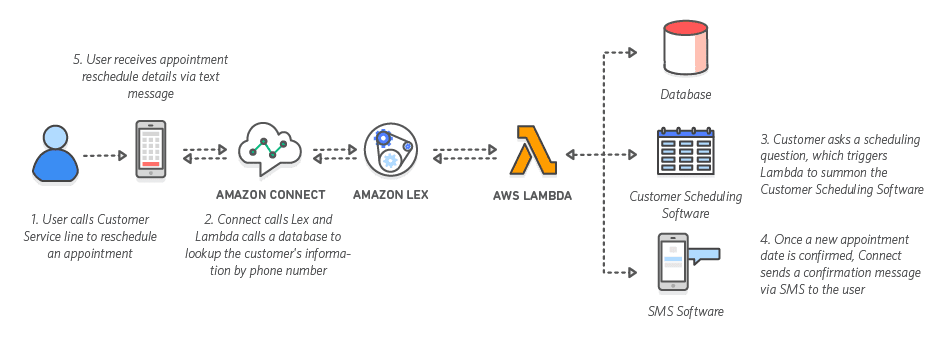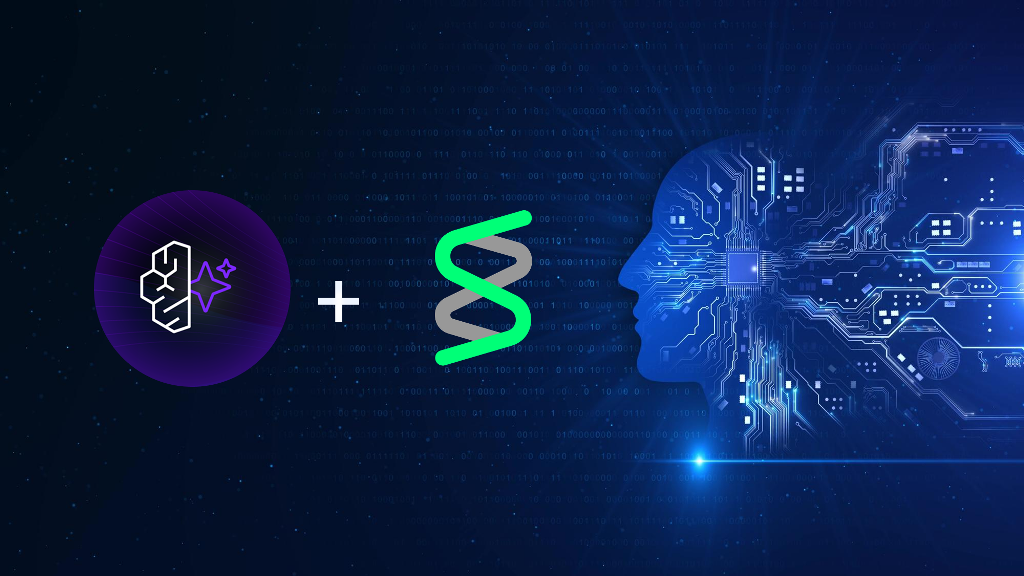
Amazon Lex Chatbot for AWS
AWS Lex Summary
Amazon Lex is a service for integrating speech and text-based conversational interfaces into any application.
When deciding on a product or service, we often have questions. When was the last time you visited the IT help desk at your place of employment for assistance? Questions like “What time does the IT Help Desk open?” and “Can you provide me with a temporary computer while your laptop is being repaired?” are common.
For several reasons, chatbots are gaining increasing importance in e-commerce and technology. One significant advantage of chatbots is their ability to provide immediate customer assistance without human intervention. This quick response time can improve customer satisfaction and help businesses streamline their customer service operations. Additionally, chatbots offer accessibility that traditional customer service channels may not provide, allowing customers to receive support anytime.
Customers are more likely to be satisfied if they receive prompt and accurate responses to their inquiries. However, it may not be the best use of their time to do so. Automating such a task is a logical choice. As a result, customers receive a prompt response and support staff can focus on solving problems.
What is Amazon Lex?
Amazon Lex enables you to build and integrate voice and text conversational interfaces into any application. Automatic speech recognition (ASR) and natural language understanding (NLU) are advanced deep learning capabilities offered by Lex that allow you to build applications with highly engaging user interfaces and humanlike conversational interactions.
Any developer can build natural language conversational bots (“chatbots”) using the same deep learning technologies that power Amazon Alexa. Amazon Lex uses the same technology as Alexa, providing a seamless and robust foundation for conversational interfaces.
You can integrate Amazon Lex with AWS Lambda to increase contact center efficiency, automate simple tasks, and drive productivity improvements across your enterprise. This combination allows you to effortlessly trigger features to execute your back-end business logic for information retrieval and updates. Once built, your bot can be deployed directly to various platforms such as chat platforms, IoT devices, and mobile clients, ensuring versatile and wide-reaching application. Amazon Lex provides a secure, scalable, easy-to-use, end-to-end solution to build, monitor, and publish your bots.
You don’t have to worry about infrastructure management because Amazon Lex is a fully managed service, making it simpler to focus on creating exceptional conversational experiences.
Benefits of AWS Lex
Amazon Lex features many user-centric engagement capabilities designed to streamline customer interactions. Integrate Lex with your existing application or AWS services to deliver a consistent user experience through and through.
Easy to use
An easy-to-navigate console helps you create a chatbot or conversational interface in minutes. Then, Amazon Lex builds a complete natural language model that your users can use to ask questions, get answers, and complete complex tasks using voice and text.
Deep learning
Speech recognition and natural language understanding are among the most difficult issues in computer science to tackle. They necessitate the use of advanced deep learning algorithms trained on enormous amounts of data and infrastructure. Thanks to Amazon Lex, all developers now have access to deep learning technology.
Amazon Lex bots transform incoming speech to text and comprehend the user’s intent to provide an intelligent response. This allows you to focus on adding value to your bots for your consumers and defining entirely new product categories enabled by conversational interfaces.
Cost-effective
There are no setup fees or minimum costs associated with Amazon Lex. Only the text or speech requests that are made are taxed. Amazon Lex is a cost-effective approach to constructing conversational interfaces anywhere due to its pay-as-you-go pricing and minimal cost per request. With Amazon Lex’s free tier, you can try it out without having to spend any money.
Scalable
You can develop, test, and deploy your bots straight from the Amazon Lex dashboard with Amazon Lex. In addition, you can publish your voice or text bots to Amazon Lex for usage on mobile devices, online apps, and communication channels (for example, Facebook Messenger). Amazon Lex scales on its own. To fuel your bot experience, you won’t have to worry about supplying hardware or managing infrastructure.
Constant Uptime
They provide consistent customer service without breaks, holidays, or downtime, which is crucial in our increasingly global and digital marketplace.

AWS Lex Tip #1: Before you start, ask yourself: 1. What is the point of this chatbot? 2. Who are your users, and what do they want to accomplish?
AWS Lex Features
Amazon Lex is widely utilized for various applications, including the development of artificial intelligence-powered chatbots that can perform tasks or provide information. The wealth of features AWS Lex provides is tailored to make every customer interaction more productive. AWS Lex features various aspects that set it apart from other platforms, which you can read in this section.
Speech recognition and natural language understanding
Amazon Lex offers natural language understanding and speech recognition services that enable developers to implement a Speech Language Understanding (SLU) system. Amazon Lex, powered by the same technology as Alexa, employs proven methods that are used by millions of people around the world.
The multiple ways users can express their intent using a few sample utterances offered by the developer is possible because of Amazon Lex’s machine learning capabilities. A speech-to-text language understanding system translates speech and text into computer language, understanding the overall intent of the inputs, and then using that to facilitate the user’s request.
Context Management
To be able to correctly classify phrases as they occur in multi-turn conversations, it is critical to keep track of the various conversational contexts. Amazon Lex uses built-in support for context management, so you can work with the context without writing additional code.
After an initial intent is completed, you can use contexts to set up a series of related intents. By reducing the complexity of bot design, you can speed up the process of creating conversational experiences.
High-quality Telephony
For telephony-specific purposes, the Amazon Lex speech recognition engine has been trained on 8 kHz audio samples, increasing speech recognition precision. Higher consistency with telephone speech interactions, such as via a contact center application or online support, is possible due to the 8 kHz support.
Bots
Bots in Amazon Lex are designed to perform automated tasks such as ordering food or booking flights and can support multiple intents. This means a single bot might help a user book a reservation or cancel it depending on the user’s needs.
Intents
Intents represent a set of actions that users want to perform. Each intent is identified by a name, such as ‘BookFlights’ or ‘OrderFood’, which describes the action the user intends to perform.
Slots
Slots are parameters necessary for fulfilling an intent. They are optional and configurable, allowing the bot to request additional information from the user if needed. Each slot has a slot type, which can be custom or built-in, and must be uniquely named within an AWS account.
Sample Utterances
Sample utterances are key phrases that trigger the intents. They define how users might phrase their requests, essentially guiding the conversational flow. For example, to fulfill the intent of booking a flight, users might say “Book a flight from New York to London.”
Intents
Intents represent a set of actions that users want to perform. Each intent is identified by a name, such as ‘BookFlights’ or ‘OrderFood’, which describes the action the user intends to perform.
Multi-turn dialog
With Amazon Lex bots, multi-turn conversations can be achieved without significant effort. Once the intent has been identified, users will be prompted for the necessary information (e.g., the location, reservation date, number of nights, etc.) to complete the intent.
With Amazon Lex, building multi-turn conversations for your chatbots is a piece of cake. To get your bot’s parameters and prompts, you simply list them in the Amazon Lex console, and Amazon Lex takes care of processing the dialogue for you by provoking the relevant variable or prompt.
Amazon Lex Partner
An Amazon Lex partner yields the knowledge and experience to help you deploy sophisticated chatbot solutions on AWS.
AWS Lex Integrations
Amazon Lex integrates with AWS Lambda, and you can also interact with many other AWS services, like Amazon Connect, Amazon Comprehend, and Amazon Kendra, through the AWS platform. Incorporating Lambda gives bots comes with pre-built serverless enterprise connectors for SaaS applications like Salesforce.

Lex and Connect
Amazon Lex is a powerful service provided by AWS that allows developers to build conversational interfaces into any application using voice and text. At its core, Lex provides the advanced deep learning functionalities of automatic speech recognition (ASR) for converting speech to text, and natural language understanding (NLU) to recognize the intent of the text, enabling you to build applications with highly engaging user experiences and lifelike conversational interactions.
As with other natural-language generation tools, with Amazon Lex and AWS Connect, you can build conversational interactions (bots) that feel more natural to your customers.
When building a chatbot, you can capture user input in the form of digits, which customers insert when interacting with the Amazon Connect contact flow. For customers’ convenience, confidential information such as account details can be input this way.
Lex and Lambda
You can set up code hooks with Lambda functions to integrate with your AWS Lex bot. To do preprocessing, confirmation, fulfillment, or both, you can define Lambda functions in your intent configuration. We highly recommend using a Lambda function as a code hook for your bot. Lambda functions are required if you want your bot to send intent information to the client application so that the task can be completed. A single Bot can only be associated with one Lambda function using Lex V2.
In Lex, the components are organized in a hierarchy. At the top level is the Lex Bot, which acts as the main construct. Within this Bot, there can be multiple Intents. These Intents represent the different actions or tasks that the Bot can understand and perform. Each Intent can contain multiple slots, which capture specific pieces of information from user input.
A Lambda function can be assigned to an alias or bot-preferred language. This Lambda function acts as the backend code that handles the logic and processing of user requests. It can be associated with different aliases or languages to adapt the bot’s behavior accordingly.
Each Intent can contain multiple slots, which capture specific pieces of information from user input. Slots are vital as they gather necessary details from users, allowing the Bot to process requests more accurately. For instance, in a booking application, slots capture data like travel dates and destinations.
Slot Types define the kind of data the slots can accept, which enhances the Bot’s ability to understand varied user inputs and respond accordingly. This categorization into Slot Types ensures that the information captured is in the correct format, aiding in more efficient data processing and fewer errors during user interactions.
It’s highly recommended that you use a Lambda function as a code hook. Lambda functions are required if you want your bot to send intent information to the client application so that the task can be completed.
Lex and Comprehend
On Lex, you can perform sentiment analysis on user utterances to get a sense of the sentiments expressed. You can gain insight into how your conversations went, or how your post-call analysis might look. An example is when you have an impression that the user has negative emotions and you can automatically create a flow to assign a conversation to a particular agent.
Amazon Lex and Amazon Comprehend work together to detect user sentiment. Amazon Comprehend’s response reveals whether the text’s overall sentiment is good, neutral, unfavorable, or mixed. The most likely sentiment for the user utterance, as well as the scores for each of the sentiment categories, are included in the response. The score indicates how likely the sentiment was properly identified.
Lex and Kendra
Amazon Lex leverages the power of AWS Kendra to enhance your bots’ performance by enabling them to swiftly retrieve answers. AWS Kendra is a sophisticated enterprise search engine driven by machine learning, seamlessly integrated with AWS Lex. This integration offers a more intuitive search experience, utilizing natural language processing to deliver precise results within your organization’s vast content repository.
Amazon Cognito plays a crucial role in boosting the capabilities of a chatbot app through its seamless integration with Amazon Lex. By leveraging identity pools, Amazon Cognito efficiently manages the security and access control of online applications. Users can securely access AWS Lex services with the AWS credentials provided by Amazon Cognito, ensuring a smooth and protected experience for both developers and end-users.
Lex and Cognito
The amalgamation of Amazon Lex with Cognito guarantees online applications’ security and access control. Amazon Cognito utilizes identity pools to furnish AWS credentials, granting individuals secure access to AWS Lex functionalities. Software developers and engineers especially like the flexibility to build and scale applications that require sophisticated natural language understanding and voice capabilities.
Lex and CloudWatch
Integrate Amazon CloudWatch to monitor the health of your Amazon Lex bots. You can use CloudWatch to acquire metrics for specific Amazon Lex operations or for your entire account’s Amazon Lex activities.
You can also set up CloudWatch alerts to receive notifications when one or more metrics surpass a threshold you establish. You can, for example, track the number of queries initiated to a bot over a set period of time, see the latency of completed requests, and set an alarm if errors exceed a certain level.

Amazon Lex Tip #2: Consider situations when the user isn’t listening closely or can’t hear what’s being said, and provide the option to repeat the previous prompt or gently handle comments like “What?” or “Where were we?”
Amazon Lex Pricing
Amazon Lex is available to try for free. For the first year after you start using Amazon Lex, you can process up to 10,000 text requests and 5,000 speech requests or speech intervals free of charge.
Each user input is treated as a separate API call during the request and response interaction. You will be charged $0.004 per speech request and $0.00075 per text request based on the amount of speech or text API queries handled by your bot. 1,000 speech requests, for example, would cost $4.00, while 1,000 text requests would cost $0.75. Your monthly charges are calculated by adding up all of your voice and text requests at the end of the month.
To find out more information on pricing, visit here.

Amazon Lex Tip #3: As you make changes, you’ll notice that Amazon Lex creates a version for these resources so you know exactly what’s being used for the bot iteration you’re testing. While it may appear small at first, concurrent and ongoing development is critical to building the optimal chat bot.
How to get started with Amazon Lex
Before you deploy AWS Lex in your organization, you should consult an expert familiar with Lex best practices. AllCode has experience working with AWS Lex to deploy sophisticated solutions.
Our expertise lies particularly in the AWS Lex and AWS Connect integration.
Related Articles
Building a Production-Ready Agent with Amazon Bedrock AgentCore + Strands Agents
Building a Production-Ready Agent with Amazon Bedrock AgentCore + Strands AgentsOrganizations today need scalable, secure, and flexible automation...
Building the Agent UI with AWS Amplify and CloudContactAI Frontend
Building the Agent UI with AWS Amplify and CloudContactAI FrontendExecutive Summary CloudContactAI needed a clean, easy-to-deploy user interface for...
Building an Agent with Amazon Bedrock AgentCore + Strands Agents
Building a Production-Ready Agent with Amazon Bedrock AgentCore + Strands Agents ✅ Executive Summary Organizations need scalable, secure, and...



